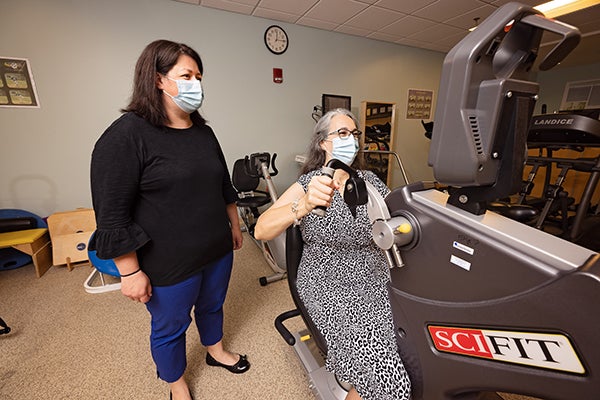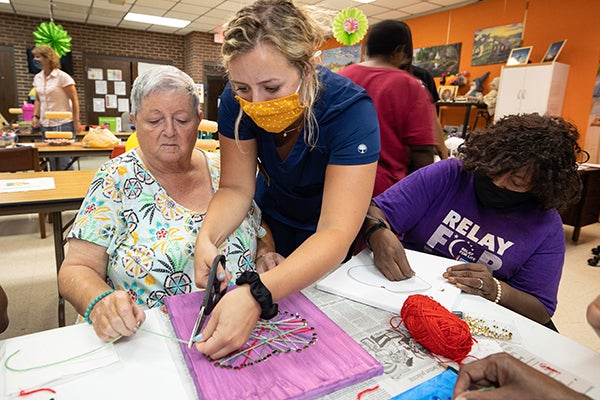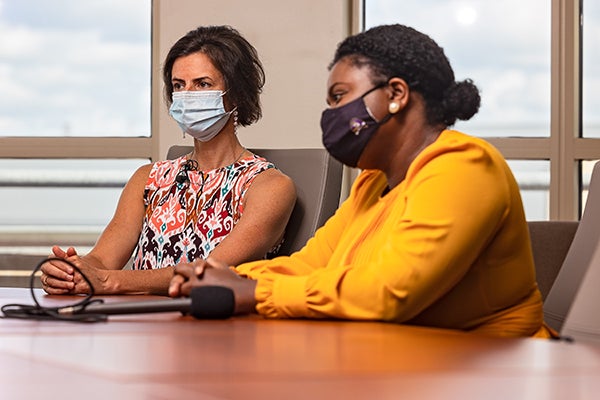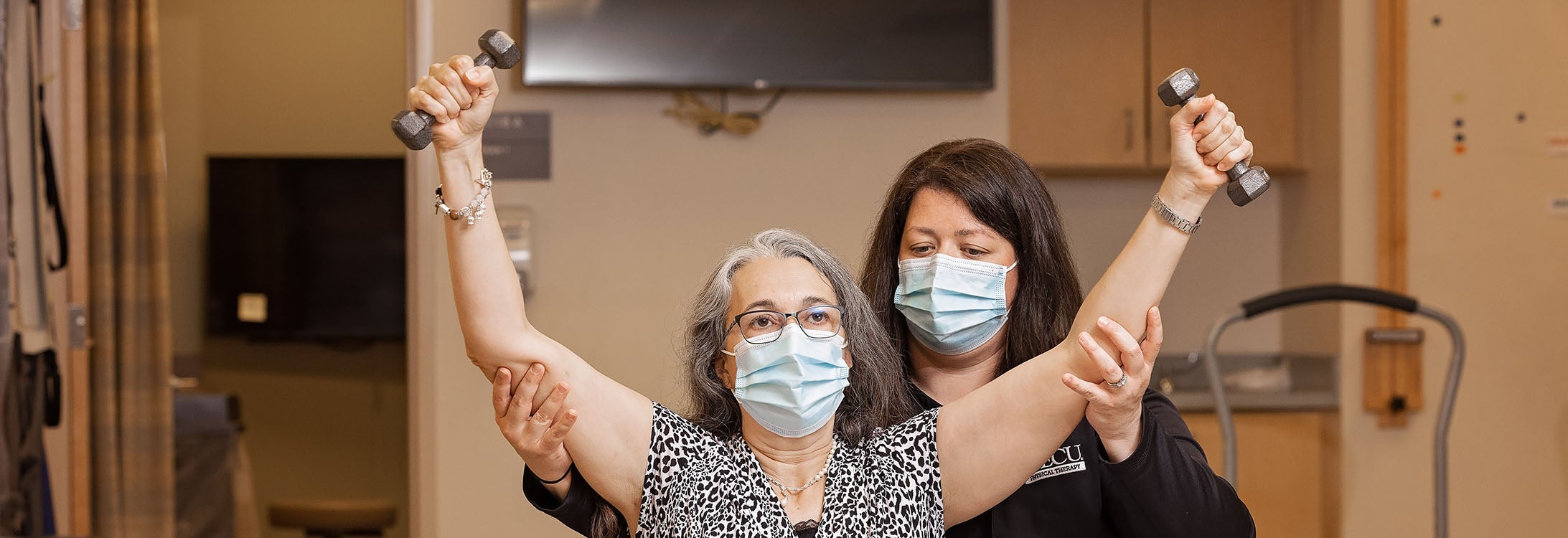HEALTH CARE AFTER COVID
For allied health professionals, work to repair the damage is just beginning
As most longtime eastern North Carolinians could tell you, sometimes the hardest part of a natural disaster is the cleanup.
After a hurricane, for example, it often takes a while to fix the power outages, repair damage and clear debris. And the injuries and deaths that hurricanes can cause leave long-lasting effects on the physical and mental health of survivors.
The COVID-19 pandemic is not unlike a natural disaster in that way. When the world tries to return to a version of “normal,” health care providers from allied health professions will continue to face a host of new issues.
Many of those who suffered from physical effects of the virus will need help from physical and occupational therapists to work toward regaining their physical abilities.
Nutritionists will continue working with those recovering from severe cases of COVID-19, those who have had eating disorders develop or worsen and the many who developed problematic dietary habits during the pandemic.
Mental health clinicians are helping people navigate all these challenges, and how their lives have been at least shifted — if not violently impacted — by COVID-19 and its ripple effects.
Rebuilding strength, reclaiming daily life
For COVID-19 survivors who were hospitalized, being released from the hospital represents only a small step toward making a full recovery.
“We quickly saw that all those people in the ICU, they were going to need some therapy — they were going to need all kinds of therapy,” said Dr. Amy Gross McMillan, chair of the Department of Physical Therapy in ECU’s College of Allied Health Sciences. “They’re going to need help getting up and moving. We saw patients getting wheeled out of the hospital and having to be helped to their vehicle. Everybody sees that celebration on the news, and (physical therapists) sit and say, ’Oh don’t let go; OK careful!’”

During their physical therapy appointments, Wedge worked with Tripp on strength, endurance, chest-opening and breathing exercises tailored to helping her get back to her daily life and off supplemental oxygen. (Photo by Cliff Hollis)
Some who experienced severe symptoms and complications, but recovered enough to be deemed safe to leave the hospital, left without the abilities to perform some of the simple, but important, tasks they were able to do before their diagnosis.
Physical and occupational therapists work with these patients to regain mobility, strength and endurance, and to reduce dependence on things like supplemental oxygen, first so that they can take care of themselves, and building toward more advanced tasks like resuming work and hobbies.
“How do you get through your day? We need to get to the bathroom. We should get dressed. We need to eat, and we need to do meal prep,” Gross McMillan said. “So, how do you get through all those things in a day and get back to anything beyond that?”
Treatment plans are created based on a client’s goals and an assessment of their capabilities and limitations.
Although each case is different, those recovering from COVID-19 can face difficulties with strength, balance and endurance. Because of the relative novelty of the disease, initially there was little information on how to treat it.
“There’s a lot of endurance training, working with energy conservation, fatigue management — that’s really what’s disabling a lot of people is that fatigue,” said Dr. Amy Wedge, a faculty member in the Department of Physical Therapy, board certified clinical specialist in neurologic physical therapy and certified brain injury specialist who has worked with several clients recovering from COVID-19. “If there’s an extended hospital stay there’s a lot of non-use, so the muscular strength is reduced. They have a lot of weakness (throughout) the entire body. There’s ICU weakness from being on a ventilator. So, it’s the muscular weakness, it’s also the breathing musculature that’s impaired.
“We’re looking at helping them conserve their energy — maybe starting off of compensatory mechanisms — so maybe using a walker or a cane, and then progressing them off of that.”
Wedge said that she commonly has these types of clients doing task-specific endurance and interval training. They also focus on breathing strategy and mechanics — “getting that chest open.”
“Some people are still coming to us on supplementary oxygen, and so we’re working on the weaning process,” Wedge said. “So, they might not need oxygen when they’re sitting still, but when they start moving those oxygen levels are dropping. So, we’re working on improving tolerance and getting off — when we can — that supplemental oxygen.”
Ginny Tripp, a nurse educator from Vanceboro, became one of Wedge’s clients after contracting COVID-19 early in 2021 and struggling to make a full recovery.
“About day 7, I started having significant trouble breathing and had to be placed on oxygen therapy,” Tripp said. “Thankfully I was at home, I wasn’t hospitalized with it — I had an (emergency department) visit and went home with oxygen at home. Just because of that, I became so short of breath that I became deconditioned and had a lot of trouble even walking a short distance. Just getting around was hard — my hips became weak; my legs and arms became weak. I would just tremble — to lift my arms up, they would just shake. So, it really caused me to not have any quality of life.
“I survived, but I couldn’t go back to work, I couldn’t play my piano. I couldn’t do things that were important to me — walking my dogs. Every day, daily activities were almost gone. It was a chore to even get my fork up to eat.”
Wedge worked with Tripp on strength, endurance, chest-opening and breathing exercises tailored to helping her get back to her daily life and off supplemental oxygen. By mid-March 2021, Tripp was able to return to work, beginning with a part-time schedule and eventually working up to full-time again.
“Therapy helped me regain my ability and strength, and I’m back at work, I’m back walking my dogs and I’m back playing my piano again. It did really work, and it helped me tremendously,” Tripp said.
Wedge emphasized Tripp’s progress as an example of the role of physical therapy as a way survivors can reclaim their quality of life after COVID-19.
“Yes, you survived COVID, but are you really living?” Wedge said. “Are you able to get back to what you want to be able to do? That’s the role of rehab.”
Teaching tomorrow’s PTs
In addition to treating patients as part of the Department of Physical Therapy’s clinical practice, faculty are seeing to it that the next generation of physical therapists is better prepared to treat COVID-19 survivors.
Students have a fall series of COVID-19 lectures with intervention that was built in the curriculum last year as part of their cardio-pulmonary coursework, Wedge said. That will be updated with the new research now that we know more.
“We teach them how to get someone on their stomach, in prone, when they have all the tubes aligned and they’re attached to the ventilator because we know that in prone increases profusion to the lungs and decreases the work of breathing,” Wedge said.
“Even though it’s not on the (board certification exam), we don’t just teach what’s on the board exam. Because it’s so new, there’s not going to be board questions on it, but this is real life; this is what you’re going to see when you become a clinician and you’re out in the clinics or in the hospitals.”
OTs putting in OT
When illnesses like COVID-19 cause people difficulties in accomplishing important day-to-day tasks, occupational therapists are the problem solvers called in to help.
Occupational therapists typically develop treatment plans based on their clients’ abilities and limitations, as opposed to their particular diagnosis.

Occupational therapists help clients overcome limitations caused by severe COVID-19 by employing strategies they’ve used to help clients overcome other illnesses. (Photo by Rhett Butler)
Patients recovering from severe COVID-19, for instance, often struggle with endurance and energy limitations, breathlessness, and some continue to require supplemental oxygen after being released from the hospital. Often, OTs helping clients overcome limitations caused by severe COVID-19 can employ strategies they’ve used to help clients overcome other illnesses.
“The way that they are trained to approach a client is that it doesn’t matter what their condition is, we’re still looking to see what those deficits are — maybe it’s energy conservation, and we have to use those strategies like we would with someone with chronic heart failure,” said Dr. Denise Donica, chair of the ECU Department of Occupational Therapy. “Maybe it’s figuring out that they may not have the energy to walk around the grocery store to get all of the groceries that they need, so maybe they have to use a motorized cart. Even if they generally wouldn’t need it to walk around, they may need it for a longer activity. Or they might be encouraged to do shorter, but more frequent trips to the grocery store.”
Donica also said she expects OTs will be called on to help address deficits in children’s developmental abilities due to setbacks caused by the pandemic. Many children who switched to remote learning went longer periods without exercising certain motor, cognitive, social, writing and sensory-processing skills they typically use more frequently in an in-person school environment.
“They weren’t able to engage in the occupations that they weren’t able to do for a time,” Donica said, adding that OTs also serve as a resource for teachers in helping students to learn and sharpen these skills.
Managing mental health, nutrition
For mental health care and nutrition and dietetic professionals, the toll that the pandemic has taken is far-reaching.
While COVID-19 has been tied to lingering mental health effects among those who have been infected, the effects stemming from the pandemic have been unavoidable for countless others.
Since COVID-19 was declared a pandemic, research has been published showing evidence of lingering mental health issues for those who have been infected. But regardless of whether someone has been infected, we’ve all be affected mentally by changes brought on by the pandemic. For years, people were more isolated, drinking more, and overdose deaths have risen.
Not surprisingly, ECU’s mental health professionals that serve the university community and clientele throughout the region, have stayed busy while staying home and continuing their services remotely.
The clinicians from the Navigate Counseling Clinic transitioned to doing virtual or phone appointments in March 2020, and found success in their new model while helping their clients work through a host of new challenges brought on by the pandemic.
“Because of the pandemic, there has been isolation, sometimes depression, anxiety and a lot of the other mental health disorders that have been a fear of our society in general – they seem to be a bit more exacerbated just because people were at home and people weren’t able to express themselves, they weren’t able to become a part of their friend groups and socialize in that way,” said Crissa Jewel Allen, a Ph.D. student in the Department of Addictions and Rehabilitation Studies and mental health counselor with the Navigate Counseling Clinic.
“The biggest thing people miss is the link between physical health and fitness and mental health, when you’re isolated for a long time, it’s difficult to kind of snap that back.”
The heightened awareness of keeping distance from others and habits like hand washing that were strongly encouraged and expected especially early in the pandemic may be more difficult to scale back on now for someone who has symptoms of anxiety or OCD, Allen said.
Mental health professionals are working to help people navigate these types of challenges
“Now that we’ve kind of flipped the switch and said ‘OK, back to normal,’ how do we get those people on board and flip them back as well? How do we take better care of our mental health and physical health and have a renewed understanding of how those things are intertwined?” Allen asked.
Although 2022 has brought more confidence into a return to in-person activities, the Navigate Counseling Clinic aims to keep at least some of their services available on a remote basis indefinitely because of the benefits that remote counseling provides to their clients.
Nutritionists, dieticians offer support
As people’s lifestyles changed during the pandemic, so did their eating habits.
For some who began working from home, a close proximity to the refrigerator and pantry led to more snacking. In the absence of a dining companion, some opted to eat meals while watching television. And comfortable, loose-fitting clothing like sweatpants that suddenly became workday appropriate for many was less likely to provide clues when someone has gained or lost weight.

Faculty member and registered dietician in the Department of Nutrition Science, Tara Wind, left, and Navigate Counseling Clinic counselor and Ph.D. student in the Department of Addictions and Rehabilitation Studies, Crissa Jewel Allen, discuss the impact of COVID-19 on nutrition and mental health. (Photo by Cliff Hollis)
“I think overall, COVID really led to an increase in stress-related eating and eating for reasons other than hunger, which now has manifested in weight gain and perhaps unhealthy eating habits,” said Tara Wind, a registered dietician, a clinical assistant professor and dietetic internship director in the Department of Nutrition Sciences.
Beyond the psychological effects the pandemic had on nutrition, physical access to ingredients changed as well as it became more difficult to find certain ingredients or products at grocery stores due to increased demand or supply chain disruptions.
For some, the effects of the pandemic on nutritional habits have been worse than a few undesired pounds gained or lost as the pandemic also resulted in an exacerbation of disordered eating and eating disorders.
“Eating disorders have gotten so much worse during the pandemic because of isolation and stress and anxiety and control over food intake,” Wind said, adding that because the last two years have felt so uncontrollable for many, food might be something viewed as one of the only things that could be controlled.
For those struggling to get a handle on nutritional habits that changed during the pandemic, Wind offered a few following suggestions:
“The first (tip) is always extending yourself some grace,” she said. “You’re not going to be able to make all these changes at once. You really need to focus on maybe the biggest thing you need to do, which might be to cut down on sodas or snacking, or (it might be) getting out more.
I like to do weekly goal-setting myself. On Sundays I sit down and I’m like ‘What do I want to do this week? What are a couple of goals that I want to accomplish?’ … when you accomplish them it makes you feel really good.”
Getting dressed for the day — even if you’re working remotely — can also be a good place to start with getting into a healthier mindset.
“One of the recommendations that my colleagues and friends are providing to their clients who are maybe in a nutrition funk or just not feeling good about themselves from a confidence level is to actually getting back into putting on work clothes,”
“Get up in the morning, make yourself look nice, take a shower. Even if you’re not (going into the office) or on video camera, if you dress nice, it inherently makes you feel better and take better care of yourself.”
She also recommended that making meals a part of an experience with others again can be a helpful step for those who feel comfortable.
“Nutrition is never by itself, it’s part of a whole picture,” she said. “Nutrition relates directly to socialization. If you’re comfortable being around your family and friends again, invite them over for dinner.”
